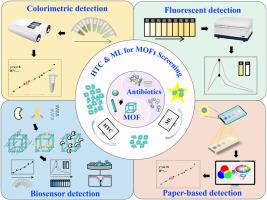新兴的基于mof的水环境抗生素检测方法:最新进展、挑战和前景
IF 8.7
Q1 Environmental Science
引用次数: 0
摘要
抗生素的滥用和处置不当导致耐药细菌和耐药基因的出现和传播,对水环境安全和人类健康构成严重威胁。因此,开发有效的水环境残留抗生素检测方法对污染控制和公共卫生安全至关重要。传统的抗生素检测方法包括色谱法、微生物法和免疫分析法等,但存在程序复杂、对熟练操作人员的要求高、成本高等问题,极大地限制了其在现场监测中的适用性。近年来,包括比色法、荧光法、生物传感器和纸基检测在内的快速检测方法得到了广泛的关注,克服了上述局限性并被广泛采用。金属有机骨架具有富集吸附、催化降解和自生荧光等明显优势,在抗生素快速检测领域具有广阔的应用前景。本文综述了基于MOFs的抗生素快速检测方法的检测原理和最新进展,并强调了MOFs在抗生素快速检测领域的独特优势和潜力。值得注意的是,讨论了用于筛选mof特定应用的高通量计算(HTC)和机器学习(ML)的最新进展和挑战,并提出了在基于mof的快速抗生素检测方法中使用它们的策略。本文综述可进一步指导MOFs抗生素检测方法的开发和优化,促进MOFs在环境抗生素检测中的实际应用。本文章由计算机程序翻译,如有差异,请以英文原文为准。

Emerging MOF-based antibiotic detection methods in water environments: Recent advances, challenges, and prospects
The misuse and improper disposal of antibiotics lead to the emergence and dissemination of antibiotic-resistant bacteria and antibiotic resistance genes, posing serious threats to water environmental safety and human health. Thus, developing efficient detection methods for residual antibiotics in water environments is crucial for pollution control and public health safety. Traditional methods for detecting antibiotics including chromatographic methods, microbiological methods, and immunoassays, suffering from issues such as complex procedures, the requirement for skilled operators, and high costs, greatly limiting their applicability in in-situ monitoring. Recently, rapid detection methods, including colorimetric, fluorescence, biosensors, and paper-based detection, have received widespread attention, overcoming the aforementioned limitations and being widely adopted. Metal-organic frameworks (MOFs) possess distinct advantages, such as enrichment adsorption, catalytic degradation, and self-generated fluorescence, making them highly promising in the field of rapid antibiotic detection. Herein, the detection principles and recent advances in rapid antibiotic detection methods based on MOFs are summarized, and the unique strengths and potential of MOFs in the field of rapid antibiotic detection are highlighted. Notably, recent progress and challenges in high-throughput computing (HTC) and machine learning (ML) for screening MOFs for specific applications is discussed, and strategies for their use in MOF-based rapid antibiotic detection methods are proposed. This comprehensive review may further guide the development and optimization of antibiotic detection methods utilizing MOFs and promote their practical applications for sensing environmental antibiotics.
求助全文
通过发布文献求助,成功后即可免费获取论文全文。
去求助
来源期刊

Water Cycle
Engineering-Engineering (miscellaneous)
CiteScore
9.20
自引率
0.00%
发文量
20
审稿时长
45 days
 求助内容:
求助内容: 应助结果提醒方式:
应助结果提醒方式:


